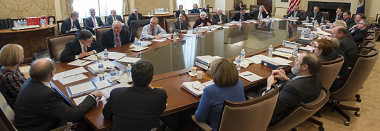from the St Louis Fed
— this post authored by David C. Wheelock, Group Vice President and Economist
“Fed watching”; is serious business for financial market participants and commentators looking for clues about the future course of U.S. monetary policy. One popular source of information is the published minutes of the Federal Reserve’s monetary policymaking committee, the Federal Open Market Committee (FOMC). This is especially true when there are dissenting votes on FOMC policy decisions.

FOMC Minutes
The minutes serve several purposes, including:
Committee members also sometimes elaborate on the reasons for their dissents in speeches or postings on Federal Reserve websites.
The FOMC’s structure allows the airing of diverse views but also encourages consensus building. Many FOMC decisions receive unanimous support, but dissents are not uncommon.
History of FOMC Dissents
Researchers have looked for patterns in the history FOMC votes.2 Since the modern FOMC structure was established in 1936, members of the Fed’s Board of Governors have dissented about as often as Reserve Bank presidents.
However, in recent years, Reserve Bank presidents have dissented much more frequently than members of the Fed’s Board of Governors. No governor has dissented since 2005. Presidents accounted for all four dissents in 2017.
Not surprisingly, dissents have tended to be more common when the economy’s performance is far from the Fed’s “dual mandate” goals of maximum employment and price stability, as in the 1970s and early 1980s. By contrast, dissents were relatively rare during the 20 years or so before the financial crisis and recession that began in 2007, when both inflation and unemployment were low and relatively stable.
Why Disagreements Occur













Leave A Comment